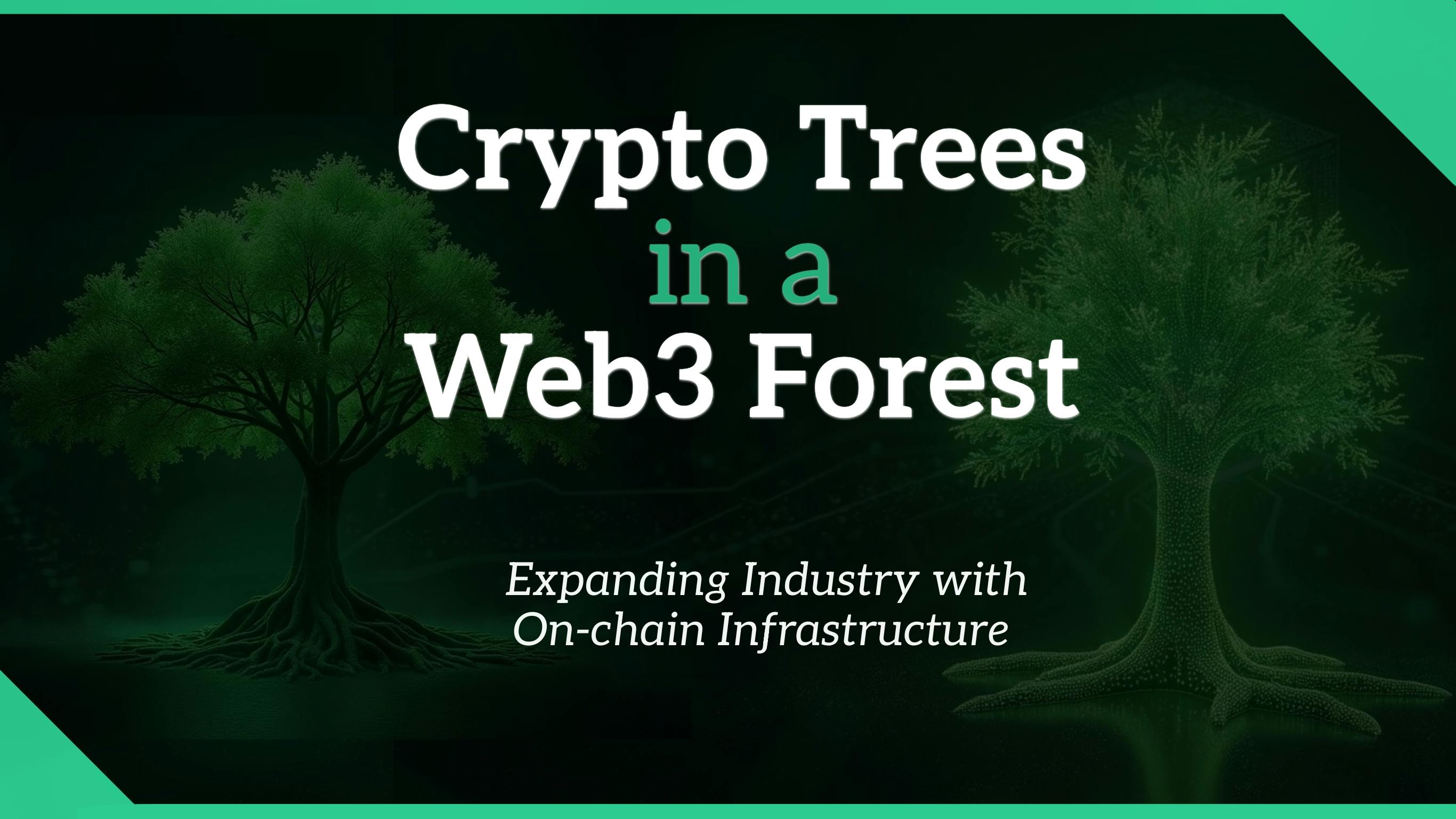Crypto gets a bad rep.
In the heat of innovation and rapid expansion, we get caught up ahead of our skis and lose the plot.
Crypto is so much more than an industry of digital tokens; it is a paradigm shift in how society operates.
A transformation of industry processes and individual freedoms.
A digital dimension of trust.
Gold 2.0;
Financial nihilism;
Memecoin supercycle;
Displacement of government.
Blossoming from nothing into a multi-trillion dollar industry anticipating continued growth in orders of magnitude, crypto is heralded as the frontier of innovation for the world’s economy, the most important and impactful technology in the history of financial markets.
From transparent supply chains to digital identities to asset issuance, the superpower of a neutral, censorship-resistant, autonomous, triple-entry accounting system (with its own sustainable incentive model) promised to rehypothecate every touchpoint of society’s digital life. To transform the fabric of commerce and resolve trust/ownership/security in cyberspace.
These lofty and opaque promises of decentralization to diffuse power, equalize opportunity, and disrupt institutions imbued the public with a frantic spirit of rebellion.
Fueled by the emotional highs of flashy headlines, parabolic returns, and geopolitical chicanery, this spirit contorts our worldview.
Rather than joining forces to solve problems, advance society, and deliver value to the world, we deviate in a PVP pursuit of shiny objects.
By all means, prosper from this as much as you can!
Just don’t get lost in sauce.
Sure, it is “cool” that a random, intrinsically worthless meme can become an instrument for society to speculate on and garner billions of dollars in market capitalization.
It’s also cool that your blockchain can process more transactions per second with the same level of security and reliability while keeping fees lower than the other.
You know what’s not cool?
Having entire industries stuck in the same place year after year and, in turn, have their economies lag in development due to the bad associations the word “Crypto” elicits.
By slowing down and asking the right questions, we zoom out, far beyond prices, to understand what is going on in the world and remember the actual role of crypto/Web3 in the grand scheme of things.
It’s impossible to anticipate where exactly the next societal paradigm shift will come from or how it will look until it arrives. Given the multi-dimensional impact of blockchain/crypto and lessons we can draw on from the uprising of the online/internet era, Web3 seems to be inevitable.
Does history actually repeat, or does it rhyme?
Web 2 — Coming On-Line
The internet has impacted society permanently and prosperously.
It was a technology so fundamentally transformative that it can be likened to the advent of the wheel.
A network of electronic devices distributed around the globe sharing information, all the time, to/from any place, 1,000x cheaper and 1,000x faster than any other method of communication.
When it first arrived, the public did not know how to interpret it.
What is this for, emailing? Legacy operators in media, journalism, and entertainment either ignored or discounted it. Although a few cunning risk takers did seek to embrace it (Amazon).
As the reflexive exponential powers of network effects accelerated its prevalence, the Internet became a force of tremendous opportunity and uncertainty.
Sensational stories of total disruption surfaced; be it for bad or good, no industry was safe from the Internet. Commerce, manufacturing, education, agriculture, finance, entertainment, and even social interaction itself was about to take on a radical new form factor.
Old industries will collapse!
New industries shall rise!
Email really will displace physical mail!..
Turns out they were not wrong orright.
They were both wrongand right.
Fast-forward to today, we witness that Web 2 did not totally replace industries; it synthesized with society/economics and expanded the surface area of operations.
It gave companies a new channel for communication, new tools for coordination, a new medium to deliver solutions through, and a new facet to increase economic value.
Meetings could be compressed.
Products could be sourced remotely.
Brands could directly interface with their audiences.
Marketers could send their messages internationally instantly.
It even gave birth to radically NEW industries and business models:
– PPC digital advertising
– Paid promotions for News site
– Affiliate systems
– Paid Courses/Tutorials
– Drop Shipping
From the ~$7,400 price point of the Dow Jones at which the internet was launched in ~1993, the economy went into a prolonged period of parabolic expansion, landing the Dow Jones around ~$40,000 (5.4x in 33 years).
But this was beyond a single country.
The world economy grew its GDP in tandem, ballooning by ~4.5x in ~33 years from $24 trillion to roughly ~$108 trillion.
The Internet became a public good that grew the entire economic pie.
Yet there is no direct investment vehicle for the internet.
Just like Web 2 led to exponential growth and transformation through the online hype cycles (Internet Bubble of 2000), the same is being done with crypto and Web3.
Web 3 — Coming On-Chain
Web3 builds upon the communicative capabilities of internet technology by adding an immutable, transparent data architecture, enabling digital scarcity and ownership.
Just how the term internet is used to refer to an enormous range of the technology/companies/products, soon too shall the term crypto become a layman’s term synonymous with all of aspects of the web3 industry.
On-Chain will become the next On-Line.
This is where perhaps the cognitive dissonance and identity crisis of the industry comes from; the technical and multi-cultural nature of crypto tends to have semantics escape us.
As you might have already known/guessed, the word “crypto” comes from “cryptography”. An extremely dense subject matter in computer science relating to digital communication, privacy, mathematics, game theory, physics, and software/hardware development.
Yet, due to its ~2 trillion dollar market capitalization, it is predominately used as a blanket term for digital money.
Colloquially, that is not incorrect. But the unintended consequence of lazy articulation is that all actual innovation becomes subconsciously translated to be associated with “crypto”.
Then, when something undesirable happens; such as the coins go down in value or malintentioned actors siphon out liquidity, hurt consumers, and get away with it richer, the image of the industry stains the technology.
Yes, crypto is digital money/assets.
It is also something much greater.
It is infrastructure; a meta-industry of code dictating and recording human behaviour.
A technology-first and an economic sector-second.
Blockchain is the technology.
Distributed, digital database with a very particular, immutable data structure.
Crypto is the application.
Tokens/coins, digitally native units of account.
Web3 is the movement.
Informational network of value. The adaptation of behavior.
A technological paradigm for how to share information, ascribe value, and place trust, ushering in a new era of economic growth. Simultaneously, an industry of its own and an extension for existing industries. A polymer of best practices from predecessor systems and Web3 capabilities.
Applying Crypto/Web3
If BTC is gold 2.0, what happens to gold 1.0?
Both objects serve the same fundamental role in society: the storage/preservation of value over time. A geopolitically neutral hedge against economic uncertainty. Only one tiny (not so tiny) difference between the two; one is physical and one is digital.
So that means, Bitcoin would eventually take over Gold’s market share and become the singular store of value due to its alignment of superior traits such as accountability, portability, and divisibility?
No.
From production and extraction cost to sentiment, value is a broad term.
If for nothing else than the sake of sovereignty, wealth diversification, and jewelry, people will always want tangible, valuable objects.
Gold 2.0 grows the economic pie substantially and compliments Gold 1.0
The “store of value” market segment expands in tandem.
In 2000, the entire size of the “storing value” market of Gold floated around $2 trillion at approximately ~$290 per ounce. BTC did not exist.
By January of 2010, the market struck ~$6 trillion at prices of ~$1,120/oz. BTC was worth maybe a thousand dollars at best.
In January of 2020, it saw ~$10.0 trillion at ~$1,570 per ounce. While BTC was worth ~$732 billion (13.66x smaller).
As of April 10, 2025, Gold Marketcap is ~$21.1 trillion with ~$3,140/oz, and BTC market cap is ~$1.6 trillion (13.185x smaller).
Gold 2.0 extends the industry; it doesn’t detract from or replace Gold 1.0
This goes far beyond gold.
The development of new cryptonative protocols, digital assets, and networks directly contributes to the evolution of legacy sectors.
Yes, we can launch tokens, create illustrious narratives, and speculate on them. We can also weave on-chain elements into mature, sophisticated industries and transform their processes, including things like DAOs and DEXs.
Web3 in Finance
Instant, immutable, superfluid, payment systems and products. Automating the accounting and maintenance of liquidity by deploying assets on-chain. Digitizing abstract financial instruments and fragmenting them for greater investor inclusivity.
Web3 in Real Estate
Altering asset liquidity profiles through fractionalization of ownership, enabling 24/7 market activity, and increasing accessibility to marketplaces. Leveraging a public ledger to prove ownership and a private one to store it.
Web3 in Education
Issuing certificates, credit attribution for scholastic breakthroughs, and collaborative efforts. Increase the reliability of your data. Reshape social experimentation with token-based incentive systems. Crowd fund endeavors.
Web3 in Sports
Transform the dynamics of fan-athlete relationships. Transform existing market structures from private to public by using crypto and blockchain. Give the public access to ownership of athletes’ contracts.
Web3 in Media
Offload servers to web3 networks and be compensated for usage. Ensure the pertinence of data by uploading to censorship-resistant chains.
Web3 in IP
Develop public ownership through fragmentation. Track content provenance. Enforce usage terms and automate concurrent micro-transactions for compensation.
Be it authentication, ticketing, identity, supply chain, payments, launchpads, AI art, or any other area that could benefit from security, transparency, and interoperability, Web3 technology will, in some way, shape, or form, augment it.
The Next Episode
It’s not a matter of IF, but WHEN.
It’s not a matter of OR, but AND.
There is no stopping the train of human digitization.
Tokenization will swallow the world’s financial assets. Every object of value shall be tokenized.
On-chain will become the universal standard for Data. Information that is not tithed to an immutable public database will not be reliable.
The techno-anarchists’ utopia assumes a unipolar world where, “in the end,” only digital assets will exist. Very Matrix. Very Sci-fi.
While I don’t have a crystal ball, I am a believer in a future where the physical and the digital exist harmoniously.
Regardless of how much Fartcoin you have; Your car will still need to drive you around, a Gold chain will still look nice around your neck, and you feel comfortable in the privacy of your own home.
Look beyond the headlines.
Look beyond the price charts.
Crypto/blockchain/web3 is permanent.
Its impact, profound.
The opportunities, prolific.
“Learn;
And then think for yourself.”
See you on-chain anon.
Life is one tremendous supercycle.












